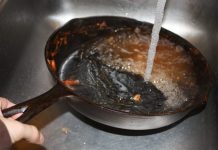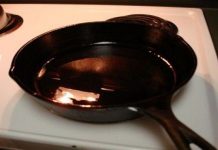In this article, we will discuss the best way to clean cast iron. Cleaning a cast iron is necessary to create a non-stick surface and the major advantage is that it prevents rusting of cast iron. To preserve its natural character you need to take special care when cleaning. If you properly take care of your cast iron items then it will improve the age and use.

Benefits of Cast Iron:
Cast iron cookware is reliable, versatile, durable, and economical. Despite its numerous advantageous, the biggest downside is the weight. They are quite heavy pieces but it is acceptable if you are not looking for a mild upper body workout while making dinner. Here is the list of some more benefits with cast iron:
- When well-seasoned its surface is naturally nonstick.
- Can handle extreme heat.
- Retains & distributes heat uniformly.
- Works well in the oven, on the stove top, and over a campfire.
- Produces a dry heat so that it can be used with very little liquid or fat.
- Prepares a crisp crust instead of causing food to “sweat”.
- Improves with age as you are re-seasoning it with every use.
- Trace amounts of iron get absorbed into the food you cook.
Best Way to Clean Cast Iron:
1.) The Vinegar Soak to Clean Cast Iron
If the rust is only on the outer surface and it is not deeply penetrated then you should skip this method. You just need to scrub the rust and your cast iron will be super cleaned without any major techniques. Vinegar soak is highly recommended method for seriously rusted-out and busted pans, Whitehead.
You need to mix basic white vinegar with water in 1:1 ratio and submerge your iron pan in it. For large pans you need to use a bucket or plug the sink. The entire skillet should be covered with the white vinegar mixture. Leave the pan to soak for about eight hours. For whitehead pan you need to keep checking it at some interval.
The vinegar has acidic properties that can help you dissolve the rust. Once the vinegar done with the rust it is also capable of penetrating or reacting with the pan so you need to remove the pan form it. We know that metal reacts with acid and it neutralizes the basic effect so the reaction between iron and acid (vinegar) can result in irreversible damage.
2.) Scrub to Clean Cast Iron
You should head to this process once you are done with the seasoning. It is not recommended to scrub a seasoned pan with soapy water but it is totally okay in this instance. You just need to use a mild detergent and warm water so it dries up quicker. After washing with detergent, clean away any lingering rust with a slightly abrasive sponge. You should avoid putting the pan in the dishwasher. You can use a green scrub pad or steel wool instead of dishwashing. Do not use any hard abrasive scrubbies, like copper scouring pads. Once you are done with scrubbing process, dry it immediately with a towel so it doesn’t catches rust again.
3.) The Re-Seasoning to Clean Cast Iron
It’s time to re-season your iron pan. There are several different methods for re-seasoning. Let’s discuss with most used method in which you have to preheat the oven to 360˚ and set a large piece of aluminum foil on the bottom rack of the oven. Rub any neutral oil with a high smoke point, like vegetable oil, all over the entire pan. Now, set the pan upside-down over the aluminum foil to catch any drips.
Allow it to bake in the oven for an hour, and then simply let it cool for at least one hour before using. You need to wipe it down every time you use your pan with another layer of oil. This will make a protective layer of seasoning and make the cast iron pan for a better cooking surface and guarding against rust.
4.) The Storage to Clean Cast Iron
Only cleaning and proper cooking is the not enough to maintain your cast iron utensils. It is also quite important to store it at right place. Do not keep the pan until it is properly dry and wiped down with oil after each use. You should store it at the cool, dry location with low humidity. Keep in mind that any excessive moisture can lead to rusting of cast iron. It has great affinity for oxygen and water for store you pan in moisture proof area. If you want to stack pans on top of one another then place few paper towel between them.
Additional Tips to Clean Cast Iron:
- After towel-drying, you should place the damp cast iron skillet over low heat on the range to ensure thorough dry.
- You should always coat your pan or skillet with a very thin coat of vegetable oil before putting it away.
- If you want to wash your pan or skillet with soap then make sure to rinse thoroughly and re-season your cast iron piece afterward.
- The benefit of coating with oil will allow the lubricant to set deeper into the pan and decrease the risk of rusting during storage.
- Warnings
- It is always suggested to avoid putting hot cast iron items into cold water. This will lead to cracking or warping of cat iron.
- Cast iron pan or skillets are best conductor of heat such that heat travels in no time from one to other. So, you need to careful while handling iron items as there might a chance that you burn yourself by touching it with unprotected skin.
- As mentioned earlier, before storing cast iron skillet of pan you should ensure that they are completely dry else they will acquire rust.
- You can’t predict whether the cast iron is hot or cold by visual inspection so you need to take proper precaution while touching it.


















